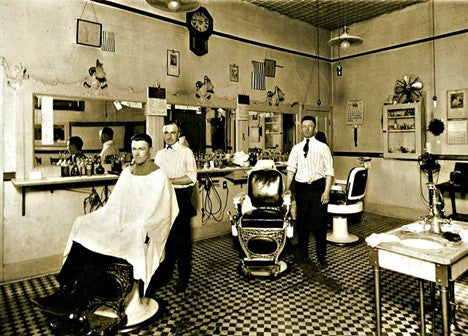The Illustrated History of Pomades
The Genesis of Pomades: 18th Century England
Throughout history, men and women alike often went to extreme lengths to execute their hairstyles to perfection. The roots of modern pomades can be traced back to 18th century England, called the Georgian era.
At that time, upper-class gentlemen sported elaborate wigs and used pomades to slick their styles into place. Those styling ointments were referred to as "pomatum," derived from the word "pomum" (Apple in Latin) because recipes included the use of overripe mashed apples paired with animal fat and perfume.
Applying pomatum on wigs allowed gentry to achieve the hairstyle they were going for but made their hair appear incredibly glossy and greasy. To counterbalance that gloss, they finished off the job with hair powder usually made of wheat flour, clay or chalk.
Wigs were notorious for their smell as they were rarely washed, and powdering helped reduce the odour. Unsurprisingly, this didn't stop the wig from being the ideal breeding ground for flies, vermin and other insects.

A man having his hair powdered by a barber in the 1700s.
By the turn of the 19th century, more natural-looking hairstyles increased in popularity, and pomades remained in use but were mostly home-made.

George IV, King of United Kingdom sporting his short Titus hairstyle, c. 1814.
First Commercial Pomades: Late 1800s and Early 1900s
The late 1800s and early 1900s saw a decline of home-made cosmetics and a rise in available commercial options. Many pomade brands started emerging, one of the first ones being Brilliantine, a hairstyling product made by French perfumer Ed Pinaud. The ointment softened men's hair, all while giving it a shiny and manicured look.

The Roaring 20s and Age of Classic Combovers
In the 1920s and 30s, most men were wearing hats, and the go-to hairstyle was a shiny slick back that wouldn't get undone by taking the hat on and off repeatedly. Petroleum and beeswax slowly started replacing animal fat as the main pomade ingredient. Brilliantine remained the product of choice to achieve that look while mass-production pomade brands such as Murray's, Sweet Georgia Brown and Royal Crown began to appear. These famous companies are still in operation today.



From left to right, pictured are three iconic 1920s hairstyles: The side part, the slick back and the mid part.
High demand for hair dressings ultimately led to the birth of modern barbershops. To keep their parted hairstyles looking sharp, hair had to be regularly maintained, and men made regular trips to visit their barbers. Hair pomades fueled the slick combovers and pompadours well into the 1960s. The term "greaser" was used to describe young men who slicked their hair back with loads of pomade.

1970s and Onward: The Decline and Rise of Hair Pomades
Pomades' use slowly began fading out in the decades to come as more hairstyling options with lower hold, and matte finishes gained popularity, with men preferring more natural-looking and voluminous hairstyles in the 1970s and 1980s.

Pomades made a big comeback in the 2010s with the rise in popularity of 20th-century inspired hairstyles such as combovers and pompadours. Many new pomade brands started launching innovative hairstyling products to fuel this new fashion trend in men's grooming.
Today's pomades are mainly water-based. Compared to their oiled-based counterparts, they wash out almost instantly, don't leave a greasy residue on clothes and don't have any adverse effects on hair and scalp. The ingredients found in today's modern pomades do include beeswax and oils, but usually in lower quantities. The disadvantage of water-based pomades is that they tend to harden-up the hair and make it flaky, sometimes even drying it out after repeated use, which in turn may cause itchiness and dandruff.
The disadvantages of modern pomades are precisely why we started developing Topgun Wax Pomade, working with world-class chemists to engineer a product that features a high hold, medium shine, no flaking and effortless washability; all while being beneficial for your hair with many conditioning ingredients.

Leave a comment
Please note, comments must be approved before they are published